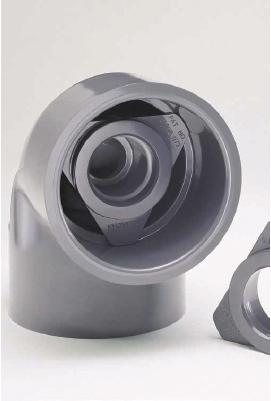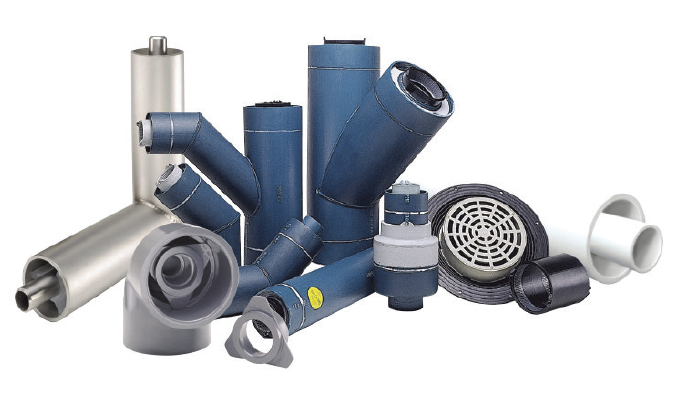Double containment piping systems for commercial and industrial applications continue to gain significant traction across multiple industries. Designed to prevent leaks and ensure the safe transport of hazardous materials, these systems have become a critical component for applications dealing with hazardous chemicals, industrial waste, wastewater treatment, and other potentially dangerous substances.

MEETING THE NEEDS OF THE MOMENT (AND THE MARKET)
Among the key drivers are stricter safety mandates and regulations amid growing concerns about environmental protection. For example:
- Under 40 CFR Part 280, the United States Environmental Protection Agency (EPA) requires double containment for underground storage tanks and associated piping. Systems that store or convey hazardous substances below ground must have some form of leak containment or mitigation. Pressurized systems also require continuous monitoring. The piping could be contained within a concrete trench, but that is very expensive. Double-containment piping is a generally more effective and less costly solution.
- The Occupational Safety and Health Administration (OSHA) has guidelines emphasizing the need for secondary containment to prevent exposure to hazardous chemicals, further enforcing safety protocols in industrial settings.
- In commercial building environments, the National Fire Protection Association (NFPA) codes, particularly NFPA 30 and NFPA 1, stipulate double containment for specific piping systems carrying flammable or combustible liquids.
These codes and standards collectively endeavor to ensure that hazardous media are safely contained, preventing leaks that could lead to litigation, costly clean-ups, and fines.
But beyond compliance with mandates and codes, a focus on protecting people, sensitive information, and valuable property is also driving the demand for safer and more efficient containment solutions. Even systems conveying potable water can cause substantial loss of property or life in certain applications.
Double containment solutions in non-mandated applications offer businesses an effective and reliable way to protect workers and other key assets, as well as the environment.

WHAT IS DOUBLE CONTAINMENT?
Double containment involves a piping system (“primary”) inside a piping system (“secondary”), creating a fail-safe method for the conveyance of fluids. If the primary pipe leaks, the leakage remains within that secondary containment, so it cannot harm anyone or anything outside the system.
These systems can be as large as 18 inches in diameter for the primary pipe, also called the “carrier” line, and 24 inches for the containment. However, the most common sizes extend from half an inch to 12 inches for the primary and 2 inches to 18 inches for the containment pipe.
Equally important is the EPA requirement that any pressurized system incorporate continuous electronic monitoring to identify leaks quickly. This combination of the preventive pipe-in-a-pipe design and continuous system monitoring is essential for applications where leaks pose serious risks.
Historically, electronic leak detection methods involved a cable sitting at the bottom of the secondary pipe and running through the entire interstitial space between it and the primary line. Should the cable become wet from a leak, it immediately signals the leak’s location to a control panel, prompting a rapid response and minimizing potential damage.
The downside of this traditional approach is that the containment pipe needs to be upsized to accommodate the cable and the cable must be removed whenever a leak occurs. An alternative solution is low-point detection where sensors are located at low points in the system. When there is a leak, it accumulates in these low points and the sensors trigger an alert to a control panel. Low-point systems are more cost-effective and customizable, offering designers and end users more options to monitor leaks.
A LOOK AHEAD
Double containment piping systems can potentially involve a range of thermoplastic and metallic materials to accommodate specific operational needs such as temperature resistance and chemical compatibility. In the second part of this article, we’ll look over the thermoplastics, metal, or combination options available when choosing a double containment system. Also, we’ll look over a successful implementation of one such system for transporting untreated frac water. As you’ll see, not only are these systems growing in popularity, they’re also providing real-world benefits in crucial applications.
Steven Dolejsi received a B.S. in mechanical engineering from Ryerson University and is the applications engineering manager at IPEX, where he has worked for over nineteen years. He can be reached at steven.dolejsi@ipexamerica.com. As the North American business of global leader Aliaxis, a leading manufacturer of thermoplastic piping systems, IPEX has more than 60 years of experience and is a leader recognized for designing and manufacturing innovative solutions to the world’s water challenges and a transition to clean energy. Our state-of-the-art manufacturing facilities, new R&D center, and distribution centers across Canada and the United States employ over 4,000+ people committed to a sustainable future and our approach to environmentally responsible manufacturing. For more information, visit www.ipexna.com.


